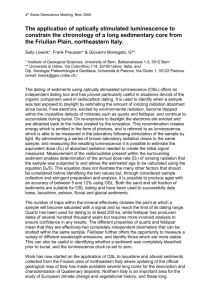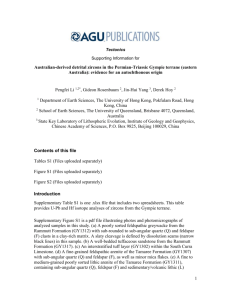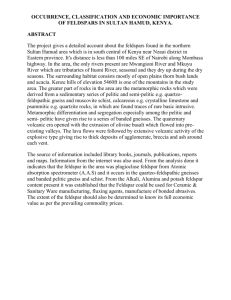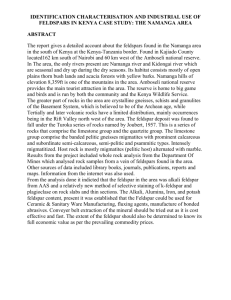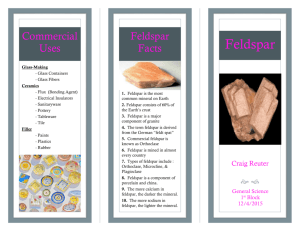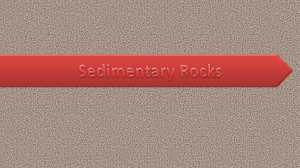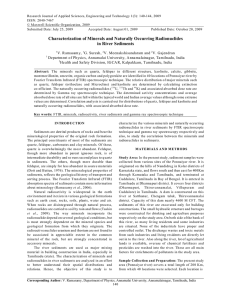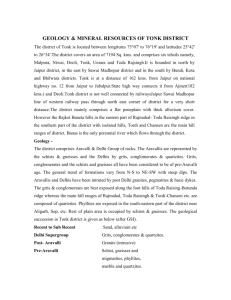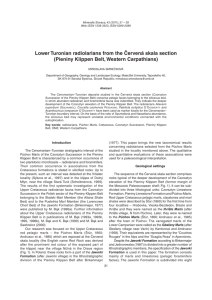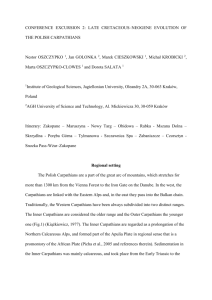Samples - Geolines
advertisement
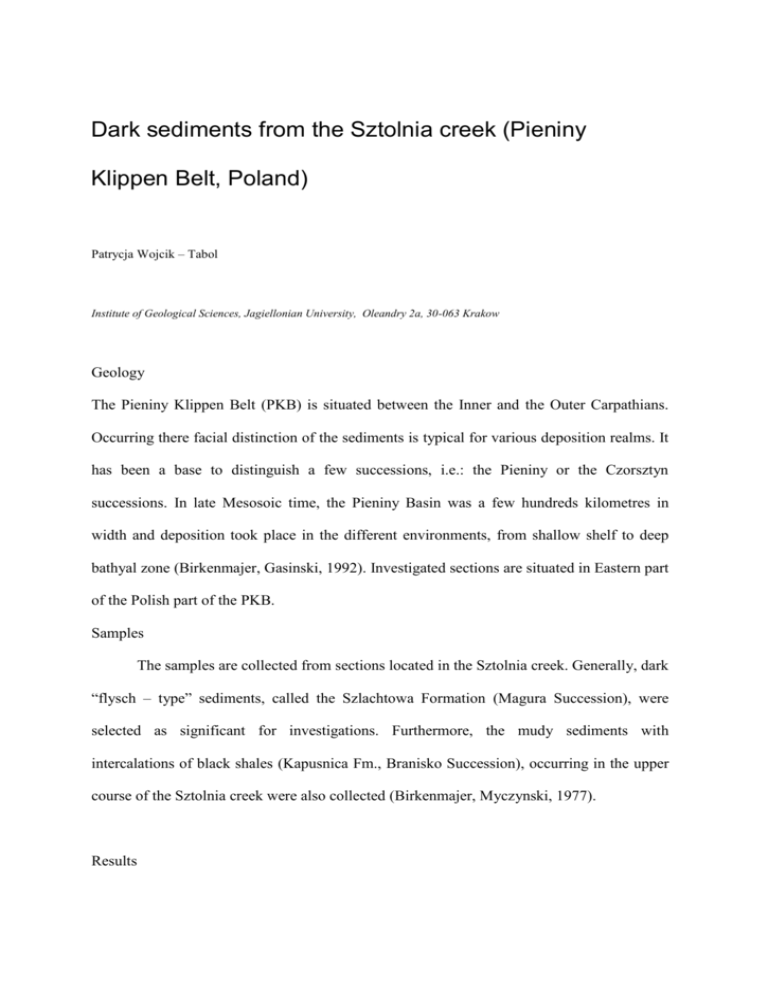
Dark sediments from the Sztolnia creek (Pieniny Klippen Belt, Poland) Patrycja Wojcik – Tabol Institute of Geological Sciences, Jagiellonian University, Oleandry 2a, 30-063 Krakow Geology The Pieniny Klippen Belt (PKB) is situated between the Inner and the Outer Carpathians. Occurring there facial distinction of the sediments is typical for various deposition realms. It has been a base to distinguish a few successions, i.e.: the Pieniny or the Czorsztyn successions. In late Mesosoic time, the Pieniny Basin was a few hundreds kilometres in width and deposition took place in the different environments, from shallow shelf to deep bathyal zone (Birkenmajer, Gasinski, 1992). Investigated sections are situated in Eastern part of the Polish part of the PKB. Samples The samples are collected from sections located in the Sztolnia creek. Generally, dark “flysch – type” sediments, called the Szlachtowa Formation (Magura Succession), were selected as significant for investigations. Furthermore, the mudy sediments with intercalations of black shales (Kapusnica Fm., Branisko Succession), occurring in the upper course of the Sztolnia creek were also collected (Birkenmajer, Myczynski, 1977). Results The complex of the dark, clastic rocks has consisted of mudstones with sandy intercalations. Sandy layers consist of calcite, quartz and feldspar. No order has been noted. Grains are angular and crushed. Quartz shows brown and purple cathodoluminescence that indicates its igneous and metamorphic origin. Blue and green luminescence is typical for feldspar, caused by Ti2+ and Mn 2+ (Marshal, 1988). Mudstones are mostly composed of clay minerals. They appear as slight sheets lying parallel. Among them, muscovite/illite and chlorite have been distinguished. Common organic matter, associated with iron sulphide has been recognized there. Pyrite appears as spherical forms (<100 m. diam.) and irregular concretions (2 mm diam.). The first one have been interpreted as pyritized plankton microfauna, i.e.: foraminiferids and Radiolaria. The samples from the upper course of the Sztolnia creek are different. Above the waterfall, the complex of disintegrating, red and grey shales has been investigated. Lamination, fractionation and irregular bioturbation have been observed. The samples are built of clay minerals (illite and sericite), quartz, dolomite, feldspar, without calcite. Quartz, dolomite and feldspar occur as relatively large grains. Red luminescence of dolomite and feldspar is activated by Fe3+. In contrary to diagenetical quartz, witch is dull. Angular fragments of carbon rich substances are dispersed in rock material. Size of grains has increased gradually, therefore term fractionation is correct. Within layers of mudstones, irregular bioturbations have been observed. Rare microfauna is represented by pyritized Radiolaria and agglutinated and benthicforaminiferids. Red part of shely complex includes slight, black intercalations. Along their lower borderline, green “shadow” has been noted. Upper boundary is acute – red material goes down in underlying black mud. Red layer contains of wispy – shape organic matter. Maximum concentration of C org has been recognized in black shales. In contrary to grey shales, reds contain of less dolomite and feldspar, but they are enriched in 7Å - clay mineral, probably Fe-Mg chlorite (chamosite). Increasing share of Mn2+ has been also determined there. Below the waterfall, black shales have occurred. Significant concentration of organic matter and iron sulphides causes their dark colour. Amorphous organic matter is dispersed or occurs as lens – shape assemblage. Benthic foraminiferids and Radiolaria have been noted. They are mostly pyritized or calcificated. Conclusions First group of investigated samples is typical for shallow water, high – energy sedimentation regime. Shely layers looks like tempestite. The organic matter has preserved thank to rapid covering by sandy material. Second type of described material represents turbiditic sediments. These were deposited on the lower continental slope, above CCD level. Bottom water might be oxic. Change of colour (red/green) reflects fluctuation of redox potential, consequent of assembly of organic matter. Organic substance has been delivered periodically. Pyritization of plankton microfauna took place probably in water column. The samples collected below the waterfall are difficult to interpretation because of strong calcification. It is possible, that they represent pelagic sediment, deposited through slow fall from water column. In all samples, diagenetical processes (early and late) have been acted. They are marked as concentration of framboidal pyrite, corroded surfaces of grains and presence of chlorite and sericite. References BIRKENMAJER K. and GASINSKI M. A. 1992. Albian and Cenomanian palaeobathymetry in the Pieniny Klippen Belt. Cretaceous Research, 13, 479-485. BIRKENMAJER K. and MYCZYNSKI R. 1977. Midlle Jurasic deposits and fauna of the Magura Succession near Szlachtowa-Pieniny Klippen Belt (Carpathians). Acta Geol. Polon., 27, 3, 387-400. MARSHAL D. J. 1988. Cathodoluminescence of Geological Materials. Unwin Hyman Ltd.

